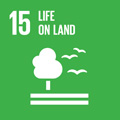- Docente: Stefano Benni
- Credits: 3
- SSD: ICAR/17
- Language: Italian
- Teaching Mode: In-person learning (entirely or partially)
- Campus: Bologna
- Corso: First cycle degree programme (L) in Sciences and Technologies for Green and Landscape (cod. 5830)
Learning outcomes
At the end of the course the student acquires knowledge and mastery of drawing techniques based on descriptive geometry, and of basic principles of CAD. At the end of the course the student has the operational ability to draw on a scale natural and anthropic elements of landscape. The ability to use CAD tools turns out to be increasingly supportive in the training process and in the professional career, and it is a prerequisite for the practice test of the qualifying examination for the profession of agronomist.
Course contents
Teaching Unit 1: Drawing tools and design standards (Lectures: 3 hours)
Expected Results: The student knows the conventions of representation and graphic rendering of technical drawings done by hand and with CAD and is able to apply them in practical exercises.
Contents:
- ISO (UNI) formats;
- Types and line weights;
- Dimensions and scales of proportion;
- Texts and symbolism.
Teaching Unit 2. Projective Geometry (Lectures: 6 hours)
Expected results: the student knows the main forms of representations that can be used in technical drawing and is able to use them for the representation of open spaces.
Contents:
- Orthogonal projections
a) plans and plants;
b) fronts;
c) sections;
- Technic shadows;
- Notes on Axonometric projections and perspective.
Teaching Unit 3. Architectural survey (Lectures: 2 hours; Practice: 4 hours)
Expected results: the student knows the operating procedures for conducting architectural surveys of open space and is able to put them into practice in case study exercises.
Contents:
- Fundamentals of architectural survey: theory and preliminary analysis of the site
- Operating modes: tools and procedures
- Field applications.
Teaching Unit 4. The computer-aided design (Lectures: 7 hours; Execcises and practice: 8 hours)
Expected Results: The student is able to use the CAD for the execution of the drawings related to the technic representation of open spaces.
Contents:
- The basic commands of a CAD
- CAD representation and layer styles
- Printing settings
- Laboratory exercises representation of an green area.
Readings/Bibliography
The topics of the course programme are treated in the following books:
- Docci Mario, Gaiani Marco, Maestri Diego, 2021. "Scienza del Disegno" Third edition. Città Studi, Novara.
- Santapaga Luigi, Trasi Matteo, 2020. "AutoCAD Guida facile al disegno CAD 2D e 3D". Apogeo.
An outline of the lectures content is provided in the following document:
- Lecture notes, available trhough the University repository.
Teaching methods
The basic concepts of technical drawing and projective geometry are going to be explained, highlighting the potential applications in the field of representation of green spaces and landscaping.
Through the study of important technical and field activities (teaching unit 3), the connection between the theories exposed, and application requirements in the field of the design of green areas and landscaping is stressed. In fact the course includes also a part of training in the field, conducted with the support and guidance of the teacher, where students put into practice the knowledge about the survey of open space taught in classroom, through measuring instruments made available by the University.
Illustrating the main characteristics of CAD software, students are given the opportunity to understand how to use, including by computer, drawing techniques learned. In particular, the teaching unit 4 'computer aided design' is carried out as a workshop activity in a computer room equipped with CAD software. The teaching method involves the carrying out of short lectures on the characteristics and operation of the software accompanied by exercises held by students with the support and guidance of the teacher. This workshop activity leads students to set and structure the main phases of exercise work required for the exam.
The theoretical and practical teaching activities of the first cycle of lessons 2020/21 will take place regularly in the presence of all students compatibly with the health conditions and with the regulations in force relating to the COVID-19 emergency. Didactic activities and university laboratories will in any case also be guaranteed online.
As concerns the teaching methods of this course unit, all students must attend Module 1, 2 <https://www.unibo.it/en/services-and-opportunities/health-and-assistance/health-and-safety/online-course-on-health-and-safety-in-study-and-internship-areas > on Health and Safety online.
Assessment methods
The course is part of the Integrated Course; therefore, the evaluation of the course takes into account jointly the level of knowledge and skills acquired by the student in relation to the contents of the two classes.
The knowledge and skills taught in this course are evaluated in the following way. The exam is carried out through oral questions concerning knowledge inherent to the entire course. The test includes the presentation of graphic products regarding the exercise, and the formulation of theory questions on different aspects of the program.
The execution of graphic tables relating to the relief of a green area is required, normally to be carried out in groups of 3-5 students and presented in the examination. We are requesting the following documents:
- Explanatory report of the surveyed area and the survey procedure, including sketches and photos;
- Top view (optionally with shadows) in CAD;
- Plant in CAD.
The graphic tables must be produced in a suitable scale and presented in tables of suitable formats ISO (UNI).
Students who can not attend classes have to contact the teacher to agree on how to proceed with these graphic tables.
Teaching tools
Overhead projector and PC for lectures. Informatic laboratory with CAD softwarefor practice.
Office hours
See the website of Stefano Benni
SDGs




This teaching activity contributes to the achievement of the Sustainable Development Goals of the UN 2030 Agenda.
